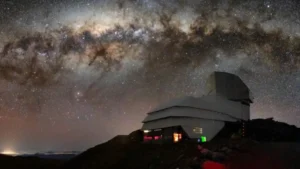There are laws of planet formation that seldom bend or break — then, there are the “forbidden” planets that do precisely that.
Around 280 million light-years away, a gas giant the size of Jupiter orbits a tiny red dwarf star. According to everything astrophysicists know about how planets form, the planet should not exist.
NASA’s Transiting Exoplanet Survey Satellite (TESS) mission found the exoplanet, which circles a star called TOI-5205. The red dwarf (a relatively dim, diminutive star) is about 40% the size of our sun and only about half as hot.
Its size makes it only about four times bigger than the newly discovered planet, called TOI-5205b, orbiting it.
What’s the upshot? A study published Feb. 21 in The Astronomical Journal indicates that the TOI-5205 system could change how we think about planetary formation.
‘TOI-5205b should not exist’
Most dwarf stars commonly host exoplanets. But because of how these stars form during their infancy, astronomers almost always find that they anchor smaller planets.
Stars cohere out of huge clouds of gas and dust floating in space. The leftover material from the formation process swirls around the star as a rotating disk. Eventually, the material coalesces as a planet.
“TOI-5205b’s existence stretches what we know about the disks in which these planets are born,” study author Shubham Kanodia, a postdoctoral fellow at the Carnegie Institution for Science in Washington, DC, said in a statement to CNN. “In the beginning, if there isn’t enough rocky material in the disk to form the initial core, then one cannot form a gas giant planet. And at the end, if the disk evaporates away before the massive core is formed, then one cannot form a gas giant planet.
“And yet TOI-5205b formed despite these guardrails. Based on our nominal current understanding of planet formation, TOI-5205b should not exist; it is a ‘forbidden’ planet.”

Artist’s rendition showing the relative size of the TOI-5205 b system compared to similar Jupiter-like planets around Solar-type stars. Image: Katherine Cain, Carnegie Institute
The team wants to investigate the planet further using the James Webb Space Telescope. It could detect if TOI-5205b has an atmosphere and lead to a better comprehension of the processes that led to its formation.
Kanodia thinks ongoing research into the unlikely planet could lead to plenty more discoveries that defy astronomers’ prevailing theories.
Observations “are already hinting at the presence of more such planets, which suggests that TOI-5205b — while definitely an outlier — isn’t the only one,” Kanodia wrote in a blog post.






